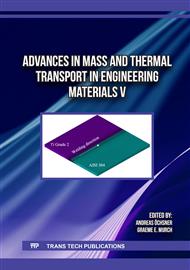[1]
Iseda A, Okada H, Semba H, Igarashi, M. Long term creep properties and microstructure of SUPER304H, TP347HFG and HR3C for A-USC boilers. Energy Mater 2007; 2:199–206
DOI: 10.1179/174892408X382860
Google Scholar
[2]
Paper: Viswanathan R, Robert Purgert. US program on materials technology for ultra-supercritical coal-fired steam power plants. In: ASME Pressure Vessels and Piping Conference 2007, Vol. 42878
DOI: 10.1361/10599490524039
Google Scholar
[3]
Yoo K.B, He Y.S, Lee H.S, Bae S.Y, Kim D.S. Study on the microstructural degradation of the boiler tubes for coal-fired power plants. KEPCO Journal on Electric Power and Energy 2018; 4(1): 25-31
Google Scholar
[4]
Lee H.S, Jung J.S, Kim D.S, Yoo K.B. Failure analysis on welded joints of 347H austenitic boiler tubes. Engineering Failure Analysis 2015; 57: 413-422
DOI: 10.1016/j.engfailanal.2015.08.024
Google Scholar
[5]
Zheng, Z, Zhang, J, Sun, X, Zhang, J, He, H, Lu, X. Failure analysis of the TP347H austenitic stainless steel tube of boiler reheater in a coal-fired power plant. Engineering Failure Analysis 2021; 121:105154
DOI: 10.1016/j.engfailanal.2020.105154
Google Scholar
[6]
Morris Jr, J.W, The influence of grain size on the mechanical properties of steel. 2001, [Internet]. Available from: https://www.osti.gov/servlets/purl/861397
Google Scholar
[7]
Anwar M.S, Widjaya R.R, Prasetya L.B.A, Arfi A.A, Mabruri E, Siradj E.S. Effect of Grain Size on Mechanical and Creep Rupture Properties of 253 MA Austenitic Stainless Steel. Metals 2022; 12(5): 820
DOI: 10.3390/met12050820
Google Scholar
[8]
Naghizadeh M, Mirzadeh H. Effects of grain size on mechanical properties and work-hardening behavior of AISI 304 austenitic stainless steel. Steel research international 2019 90(10): 1900153
DOI: 10.1002/srin.201900153
Google Scholar
[9]
R.P. de Siqueira, J.F.S. Feiteira, D.J.R. da Costa, J. Fabrício, C. Lins. Investigation of the Grain Growth Evolution in the AISI 304H Austenitic Stainless Steel. Journal of Mechanics Engineering and Automation 2016; (6):95-99
DOI: 10.17265/2159-5275/2016.02.005
Google Scholar
[10]
Sun G, Zhao M, Du L, Wu, H. Significant effects of grain size on mechanical response characteristics and deformation mechanisms of metastable austenitic stainless steel. Materials Characterization 2022; 184:111674
DOI: 10.1016/j.matchar.2021.111674
Google Scholar
[11]
Jin X, Xia X, Li Y, Zhao Y, Xue F, Zhang G. Quantitative study of microstructure evolution and the effect on mechanical properties of Super304H during aging. Materials at High Temperatures 2019; 36(5):459-470
DOI: 10.1080/09603409.2019.1632508
Google Scholar
[12]
Zieliński A, Wersta R, Sroka M. The study of the evolution of the microstructure and creep properties of Super 304H austenitic stainless steel after aging for up to 50,000 h. Archives of Civil and Mechanical Engineering 2022;22(2):1-24
DOI: 10.1007/s43452-022-00408-6
Google Scholar
[13]
Shanthi G, Nanibabu M, Krishnan S.A, Moitra A, Vasudevan, M. Effect of Thermal Aging on Deformation and Fracture Properties of SS 304HCu. Journal of Materials Engineering and Performance 2022;12:1-10
DOI: 10.1007/s11665-022-07408-w
Google Scholar
[14]
Horváth J, Král P, Janovec J. The effect of σ-phase formation on long-term durability of welding joints in SUPER 304H steels. Acta Phys. Pol. A 2016;130:960-962
DOI: 10.12693/APhysPolA.130.960
Google Scholar
[15]
Zieliński A, Wersta R, Sroka M. Analysis of the precipitation process of secondary phases after long-term ageing of the S304H steel. Bulletin of the Polish Academy of Sciences. Technical Sciences 2021;69(5)
DOI: 10.24425/bpasts.2021.137520
Google Scholar
[16]
Paper: MURATA M, TANAKA H, ABE F, IRIE H. Assessment of Material Degradation Based on Microstructural Evolution in Type 304H Stainless Steel During Long-Term Creep (Changes in Microstructure 2). In Creep: proceedings of the... international conference on creep and fatigue at elevated temperatures 2001;1:383-387. http://dl.ndl.go.jp/info:ndljp/pid/10351952
DOI: 10.1016/s0921-5093(01)01012-7
Google Scholar
[17]
Pulsford C, J, et al. Microstructural characterization of creep tested advanced austenitic stainless steel super 304H. Materials at High Temperatures 2022;39:416-426
DOI: 10.1080/09603409.2022.2037328
Google Scholar
[18]
ASTM A213/A213M-06a. Standard Specification for Seamless Ferritic and Austenitic Alloy-Steel Boiler, Superheater and Heat-Exchangers Tubes, 2006 [Internet]. Available from: https://www.astm.org/a0213_a0213m-18.html
DOI: 10.1520/a0213_a0213m-09b
Google Scholar
[19]
ASTM E139-11. Standard Test Methods for Conducting Creep, Creep-Rupture, and Stress-Rupture Tests of Metallic Materials, 2018 [Internet]. Available from: https://www.astm.org/e0139-11r18.html
DOI: 10.1520/e0139-00e01
Google Scholar
[20]
Tamura M, Abe F, Shiba K, Sakasegawa H, Tanigawa, H. Larson–Miller constant of heat-resistant steel. Metallurgical and materials transactions A 2013; 44(6): 2645-2661
DOI: 10.1007/s11661-013-1631-0
Google Scholar
[21]
Sourabh K, Singh JB. Creep behavior of alloy 690 in the temperature range 800–1000°C. Journal of Materials Research and Technology 2022;17:1553-69
DOI: 10.1016/j.jmrt.2022.01.060
Google Scholar
[22]
Sawada K, Hatakeyama T, Sekido K, Kimura K. Microstructural changes and creep-strength degradation in 18Cr-9Ni-3Cu-Nb-N steel. Materials Characterization 2021;178:111286
DOI: 10.1016/j.matchar.2021.111286
Google Scholar
[23]
Loghman A, Moradi M. Creep damage and life assessment of thick-walled spherical reactor using Larson–Miller parameter. International Journal of Pressure Vessels and Piping 2017;1(151):11-9
DOI: 10.1016/j.ijpvp.2017.02.003
Google Scholar
[24]
NIMS Creep data sheet No.56A. Data sheets on the elevated-temperature properties of 18Cr-9Ni-3Cu-Nb-N stainless steel tubes for power boilers (KA-SUS 304J1 HTB) 2018. https://smds.nims.go.jp/MSDS/ja/sheet/Creep.html#4
Google Scholar
[25]
ASTM E112-13. Standard test methods for determining average grain size, 2021 [Internet]. Available from: https://www.astm.org/e0112-13r21.html
Google Scholar
[26]
Hong H.U, Rho, B.S, Nam, S.W. Correlation of the M23C6 precipitation morphology with grain boundary characteristics in austenitic stainless steel, Mater. Sci. Eng. A 2001;318:285–292
DOI: 10.1016/S0921-5093(01)01254-0
Google Scholar
[27]
Alsmadi Z.Y, Abouelella H, Alomari A.S, Murty K.L. Stress-controlled creep–fatigue of an advanced austenitic stainless steel at elevated temperatures. Materials 2022; 15:3984
DOI: 10.3390/ma15113984
Google Scholar
[28]
Bai J.W, et al. Coherent precipitation of copper in Super304H austenite steel, Materials science and engineering A 2013;584:57-62
DOI: 10.1016/j.msea.2013.06.082
Google Scholar
[29]
Chi C.Y, et al. The precipitation strengthening behavior of Cu-rich phase in Nb contained advanced Fe-Cr-Ni type austenitic heat resistant steel for USC power plant application, Progress in Nature Science: Materials International 2012;22(3):175-185
DOI: 10.1016/j.pnsc.2012.05.002
Google Scholar


